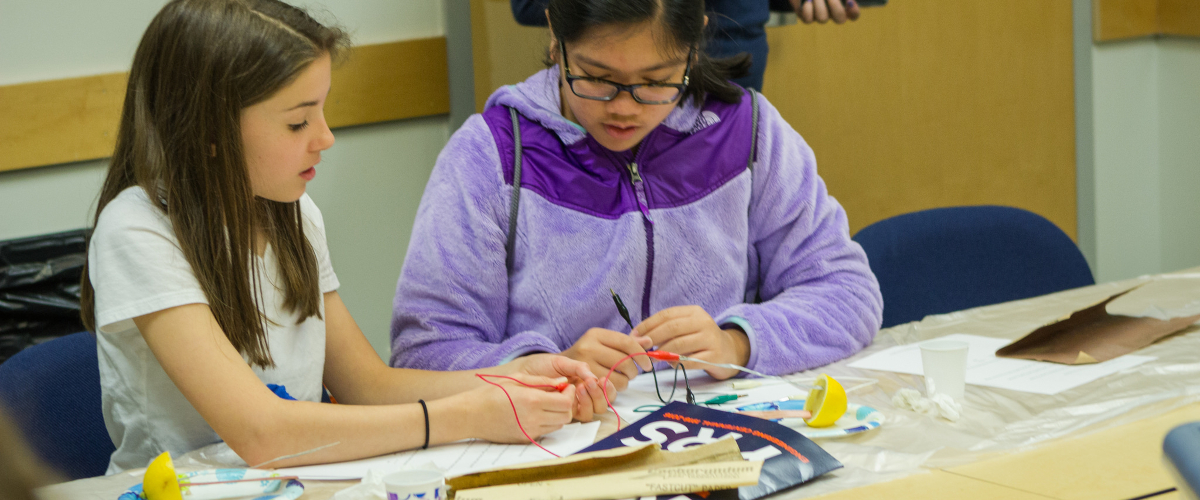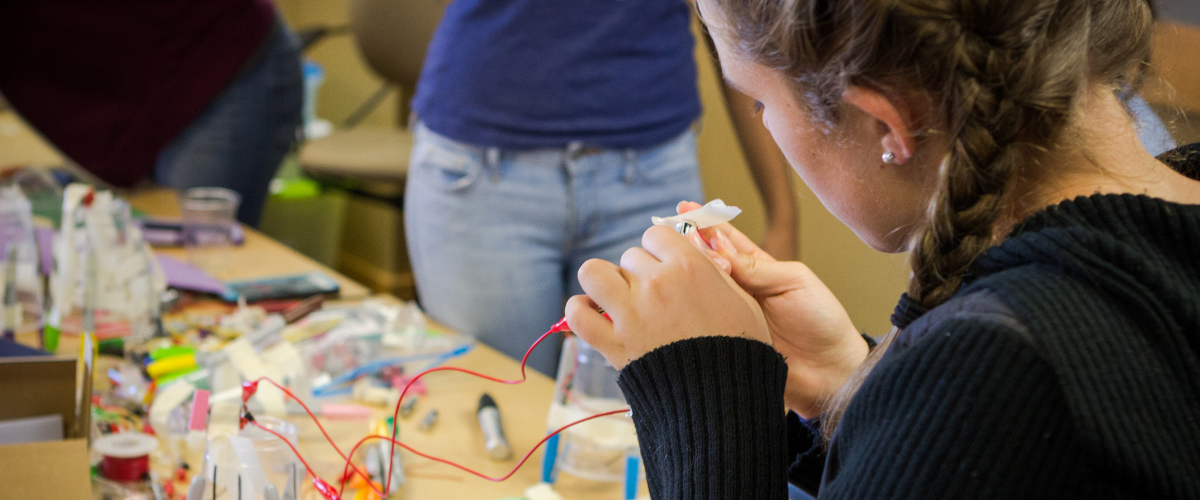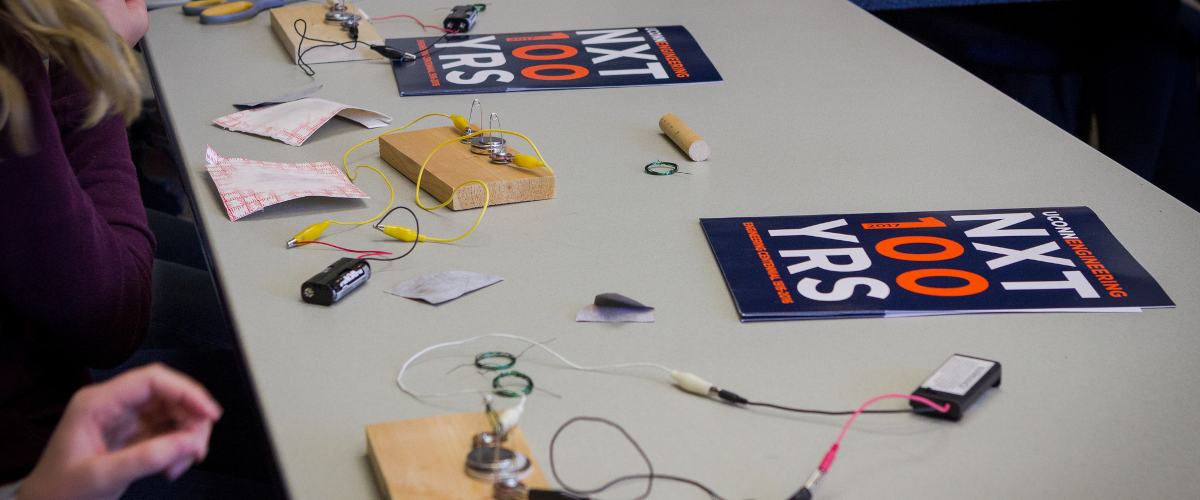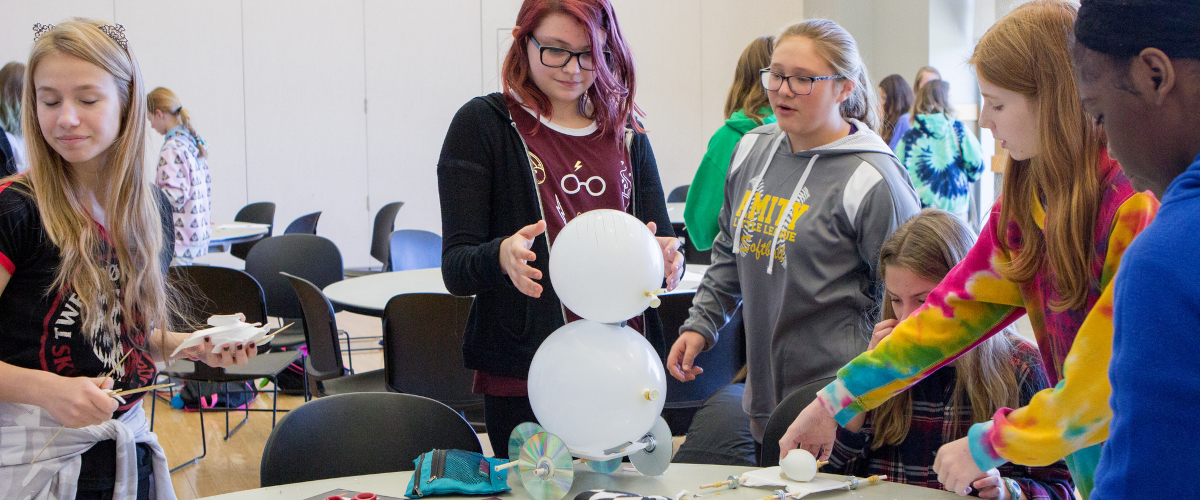




Program Details
Multiplying Her Options
Encouraging girls and young women to pursue opportunities in science, mathematics, engineering, and technology
Transportation Information
For the first time since 2019, Multiply Your Options will be held in-person for the Fall 2024 conference! Thus, transportation will be necessary for this conference. Each school will have to arrange transportation to and from the event. Please email any questions about transportation to engr-myo@uconn.edu
What Does She Want to Be and Why?
Historically the arenas of science, mathematics, engineering and technology have not always provided welcoming atmospheres for women. In fact, these professions have been constructed in somewhat of a “masculine” mode while other fields have been thought to be more feminine. Perceptions about gender-based careers have influenced the choices that females make regarding career decisions, and these choices have an impact on their futures.
If you were to ask females between the ages of 14-18 the question “what do you want to be?” according to the1 State of Our Nation’s Youth report, 12% indicate teaching; 10% medical doctor; 7% law; and another 7% would indicate nursing. However, if you were to ask males of the same age the same question, the report indicates that 11% of the males would indicate engineering, 7% would say business, 6% a career in computer software and another 6% would indicate a career in computer hardware. So why do females select certain areas at a significantly lower percentage than males?
The answer may be that females self-select themselves out of opportunities that appear to be “masculine”, too difficult or out of their own realm of ability not realizing that the consequences may limit their choice of career opportunities, involve lower pay, less challenge and even limited career growth.2 Girls progress through a school and social system in which their interaction with peers, teachers, guidance counselors and even their own family members (including parents) indirectly, and often unconsciously, turns them off to opportunities in science mathematics, engineering and technology. Our daughters, nieces and female students experience the body language changes and face shriveling at the mention of the word “math”.
Negative messages about having an interest in science, mathematics, engineering and technology are rampant for girls. The few women mathematicians, scientists, and engineers depicted in textbooks further complicate the situation and little is done to counter false perceptions and misinformation. It is obvious that our female students should have the same ability and opportunity to pursue careers in science, mathematics, engineering and technology as males, but what happens to the females by the time they graduate from high school that leads them to self-select out of these areas?
YES She Can!
Psychologist Albert Bandura (1977) introduced a concept about the relationship between one’s belief and how well one can perform a given task or behavior called ” self-efficacy”. Self-efficacy can be increased through four sources of information: past performance accomplishment, vicarious learning (seeing others model the behavior), encouragement and support, and physiological arousal (such as lowered anxiety) 3[SEE TABLE 1].
Self-efficacy expectations mediate behavior and behavioral change. In other words the level of self-efficacy expectations and the degree of difficulty of the task one believes she is capable of completing influences the behaviors attempted and those avoided. A female with high self-efficacy to become an engineer who sees the uphill struggle as too big of an effort for the perceived pay-off, may decide to pursue nursing instead. In a sense she perceives the behavior required for the successful pursuit of engineering as a negative. Bandura emphasizes that perceived outcome expectations need to be sufficiently positive in order to motivate an individual to perform a given behavior. Therefore a strong degree of positive reinforcement and confidence building needs to take place in order for female students to take on the pursuit of a career interest in science, mathematics, engineering and technology.
What Can We Do For Her?
Vicarious learning (seeing others model a behavior) in the form of female role models can be a powerful source for building self-efficacy. However research suggests that at a very young age, females (and males) are lacking in their exposure to significant female roles models in science, mathematics, engineering and technology. The current educational system introduces all students to Einstein, Newton and Edison, but how about Hypatia, Noether and Hopper? 4
Multiply Your Options is one of several programs utilized at the University of Connecticut to combat the lack of exposure to professional female role models in the areas of science, mathematics, engineering and technology. Multiply Your Options (MYO) is a one-day conference for middle school girls designed to expose them to female role models in science, mathematics, engineering and technology. The MYO concept can be used for multiple constituencies in order to address the lack of role models, gross under-representation and lack of diversity in certain career clusters (such as engineering with a female representation of only 8%).
MYO is a one-day conference consisting of two sessions. The morning session involves hand-on workshops or problem solving activities conducted by female facilitators with science, mathematics, engineering and technology focused careers. The facilitators have a built in message: “if I can, you can!” Secondly, the afternoon sessions consist of an interactive panel activity called “tool clues”. During a tool clues panel session, female role models are asked to bring from work objects or “tools” that give “clues” about their profession. It’s up to the girls, now in small groups, to determine what each woman does for a living.
A MYO conference, properly planned, can address all four areas that Bandura mentioned as being essential elements to building self-efficacy. Female mathematicians, scientists and engineers are invited to be workshop facilitators (vicarious learning). These female professionals are asked to reinforce the message “yes you can” (encouragement), to utilize hands-on problem solving activities or creative projects in the workshops (past performance accomplishment) and finally girls participate with girls only, without the pressure of being graded in the presence of male classmates, which may lower anxiety levels (physiological arousal) because each workshop is a self-exploratory activity lacking teacher scrutiny or grading in math or science.
MYO may also be used to spark the interests of talented females seeking a way to explore already identified abilities in the area of mathematics and science. MYO can be classified a Type I enrichment activity which is one of the three components of the Enrichment Triad Model 5. The Triad Model was developed to encourage creative productivity in young people by exposing them to various topics, areas of interest and fields of study and to further train students to apply advanced content, process-training skills and methodology training to self-select areas of interest [SEE TABLE 2].
Three types of enrichment are included in the Enrichment Triad Model. Type Is are general exploratory activities designed to expose students to a wide variety of disciplines, occupations, persons, places and events that would not ordinarily be covered in the regular curriculum. Type IIs are group training activities and Type IIIs provide opportunities for individual or small group investigations of real problems.
MYO is a Type I enrichment activity that allows female students to leave the regular school setting for a day and explore the wide variety of opportunities that are available to them in the areas of science, mathematics, engineering and technology. After attending an event such as MYO, our hope is to have females self-initiate Type II training and Type III studies. Type IIIs enable students to have the opportunity to apply interests, creative ideas, advanced-level understanding, self-directed learning skills, self-confidence and feelings of creative accomplishment. This leads towards the development of self-efficacy and the probability that more females will pursue careers in science, mathematics, engineering and technology. Girls see what they like, believe they can do it, prove it to themselves and feel good about these actions.
The University of Connecticut has held dozens of Multiply Your Options conferences since 1995. Over 1,000 girls have participated, with more than 150 female professionals in science, mathematics, engineering and technology careers. The steps to starting a Multiply Your Options Conference is relatively easy with the proper amount of help. The most important step is to construct a planning committee a year in advance [SEE TABLE 3]. This planning committee should consist of parents, educators, industry, and community representatives. It is important to involve individuals who want to make a difference and recognize the problem of under-representation of females in the areas of science, mathematics, engineering and technology.
What is in Her Future?
“The genius of women in this industry has not been tapped. The companies that finally figure out how to tap into that genius are going to eat everyone else’s lunch.”
According the National Science Foundation, three times as many men now earn computer science degrees and the bulk of the women who do work in the computer industry are clustered in low-paying jobs. We already use computers as everyday tools in most offices and schools so as our economy becomes more technological, those without skills will find themselves at a loss in the job market. So when female students become disinterested in mathematics, science and engineering they are shutting themselves out of opportunities in computers and technology, the careers of the future.
An important message needs to reach our female students and that message is that careers in science, mathematics, engineering and technology are the future. Of today’s kindergarten students, 90% will be doing jobs in adulthood that do not exist today. In addition, excluding sales, the highest paying occupations will be those requiring the highest technical skills such as computer systems, analysis, programmers, engineers, technicians, and repair and service personnel. The demand for a technologically advanced workforce and the rate of change in technology has dramatically increased the added pressure for careful and earlier career management. If our next generations of young women want to compete economically, technology must be included in their future. And now is the time to multiply her options.
Appendix
Table 1. Bandura’s Concept of Self-Efficacy
| FOUR SOURCES OF INFORMATION | WHAT SHE SAYS |
| 1. Past Performance accomplishment | I have done this before and I was successful |
| 2. Vicarious learning | I’ve seen other females like me do this |
| 3. Encouragement and support | I can do this because she says I can |
| 4. Physiological arousal | This is not hard and it does not scare me |
Table 2. Type I, II & IIIs (part of the Enrichment Triad Model)
| TYPE I: General Exploratory Activities | TYPE II: Group Training Activities | Type III: Investigations of Real Problems |
| METHODS OF DELIVERY
Audio or video tape Computer program Debate Field trips/workshop participation (MYO) Learning or interest center Newspaper or magazine articles, performance |
PROCESS SKILLS THAT CAN BE DEVELOPED
|
FIVE ESSENTIAL ELEMENTS
|
Table 3. How to Start a Multiply Your Options Conference
| Construct a Planning Committee | 8-10 representatives from education, industry, universities or communities. One year in advance |
| Identify Funding Sources or Sponsors | Large employers, technical professional societies, National Science Foundation, superintendents etc… |
| Outline Dates, Deadlines and Overall Structure | Prepare a conference agenda, 1/2 day or full day schedule, response time deadlines |
| Locate and Secure A Site | Large conference meeting hall or center with multiple breakout rooms, settings with classrooms |
| Identify Sources for Female Professionals | Society of Women Engineers, Association of Women in Science, American Association of University Women, Colleges & Universities |
| Identify Participating Schools | Start small (25 to 50 participants) and work your way up (100 – 150) year by year |
References
- Alger, H. and Associates (1998). The state of our nation’s youth 1998-99, Commissioned
Report. Alexandria, VA: Horatio Alger Association of Distinguished Americans, Inc. - Blaisdell, S. (1995). Factors in the underrepresentation of women in science and engineering, a review of the literature Women in Engineering Programs Advocate Network. Working paper 95-1.
- Bandura (1977). Social learning theory. Englewood Cliffs, NJ: Prentice-Hall.
- Edeen, S. & J., Slachman (1990). Portraits for classroom bulletin boards: women mathematicians. Palo Alto, CA: Dale Seymour Publications.
- Renzulli, J & Reis, S. (1997). The schoolwide enrichment model: a how-to guide for educational excellence-second edition. Mansfield, CT: Creative Learning Press, Inc.